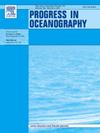Tidal energetics in the eddying South China Sea from a high-resolution numerical simulation
IF 3.8
3区 地球科学
Q1 OCEANOGRAPHY
引用次数: 0
Abstract
Understanding tidal energetics is crucial for comprehending complex oceanic processes in the South China Sea (SCS). Tidal energy budget in different parts of the world’s oceans has been widely estimated, but the dissipation pathways of tidal energy in the eddying ocean remain elusive. Based on a well-validated high-resolution numerical simulation, this study provides an updated estimate of tidal energy budget in the SCS with the modulation of realistic background currents and stratification. It reveals that ∼19.72% of barotropic tidal energy input in the Luzon Strait (LS) is converted to baroclinic tides, ∼75.66% of which is transmitted out of the LS and the other ∼24.34% is dissipated locally. Additionally, ∼61.20% of barotropic tidal energy is transmitted into the SCS, and the other ∼19.07% is dissipated locally. Analysis of barotropic tidal energy budget highlights significant work rate of K1 tide-generating force in the SCS, whereas analysis of baroclinic tidal energy budget reveals the impacts of background fields on energy conversion from barotropic to baroclinic tides and energy dissipation of baroclinic tides. The seasonal variability of tidal dynamics and energetics further highlights the modulations by background fields. An exponential decay of baroclinic tidal energy flux with the distance from the generation site is revealed, and the decay scales for K1 (northwestward and southwestward beam of M2) baroclinic tide are estimated as 404 (195 and 127) km. A simple scaling of baroclinic tidal energy flux in the SCS, which may be used to characterize tidal mixing in large-scale ocean and climate models, is thus devised.
南海涡旋潮汐能量的高分辨率数值模拟
了解潮汐能量学对于理解南海复杂的海洋过程至关重要。世界海洋不同地区的潮汐能收支已经得到了广泛的估计,但潮汐能在旋转海洋中的耗散途径仍然难以捉摸。基于高分辨率数值模拟,本研究提供了在实际背景流和分层调制下南海潮汐能收支的最新估计。结果表明,吕宋海峡(LS)输入的正压潮汐能中有~ 19.72%转化为斜压潮汐能,其中~ 75.66%从吕宋海峡传输出去,其余的~ 24.34%在当地耗散。此外,约61.20%的正压潮汐能被传输到南海,另外约19.07%被局部耗散。正压潮汐能收支分析强调了南海K1产潮力的显著功率,斜压潮汐能收支分析揭示了背景场对正压向斜压潮汐能量转换和斜压潮汐能量耗散的影响。潮汐动力学和能量学的季节变化进一步突出了背景场的调制作用。斜压潮能通量随距离产生地点的距离呈指数衰减,K1 (M2的西北和西南波束)的衰减尺度分别为404(195和127)km。因此,设计了一个简单的南海斜压潮汐能通量标度,可用于表征大尺度海洋和气候模式中的潮汐混合。
本文章由计算机程序翻译,如有差异,请以英文原文为准。
求助全文
约1分钟内获得全文
求助全文
来源期刊

Progress in Oceanography
地学-海洋学
CiteScore
7.20
自引率
4.90%
发文量
138
审稿时长
3 months
期刊介绍:
Progress in Oceanography publishes the longer, more comprehensive papers that most oceanographers feel are necessary, on occasion, to do justice to their work. Contributions are generally either a review of an aspect of oceanography or a treatise on an expanding oceanographic subject. The articles cover the entire spectrum of disciplines within the science of oceanography. Occasionally volumes are devoted to collections of papers and conference proceedings of exceptional interest. Essential reading for all oceanographers.
 求助内容:
求助内容: 应助结果提醒方式:
应助结果提醒方式:


